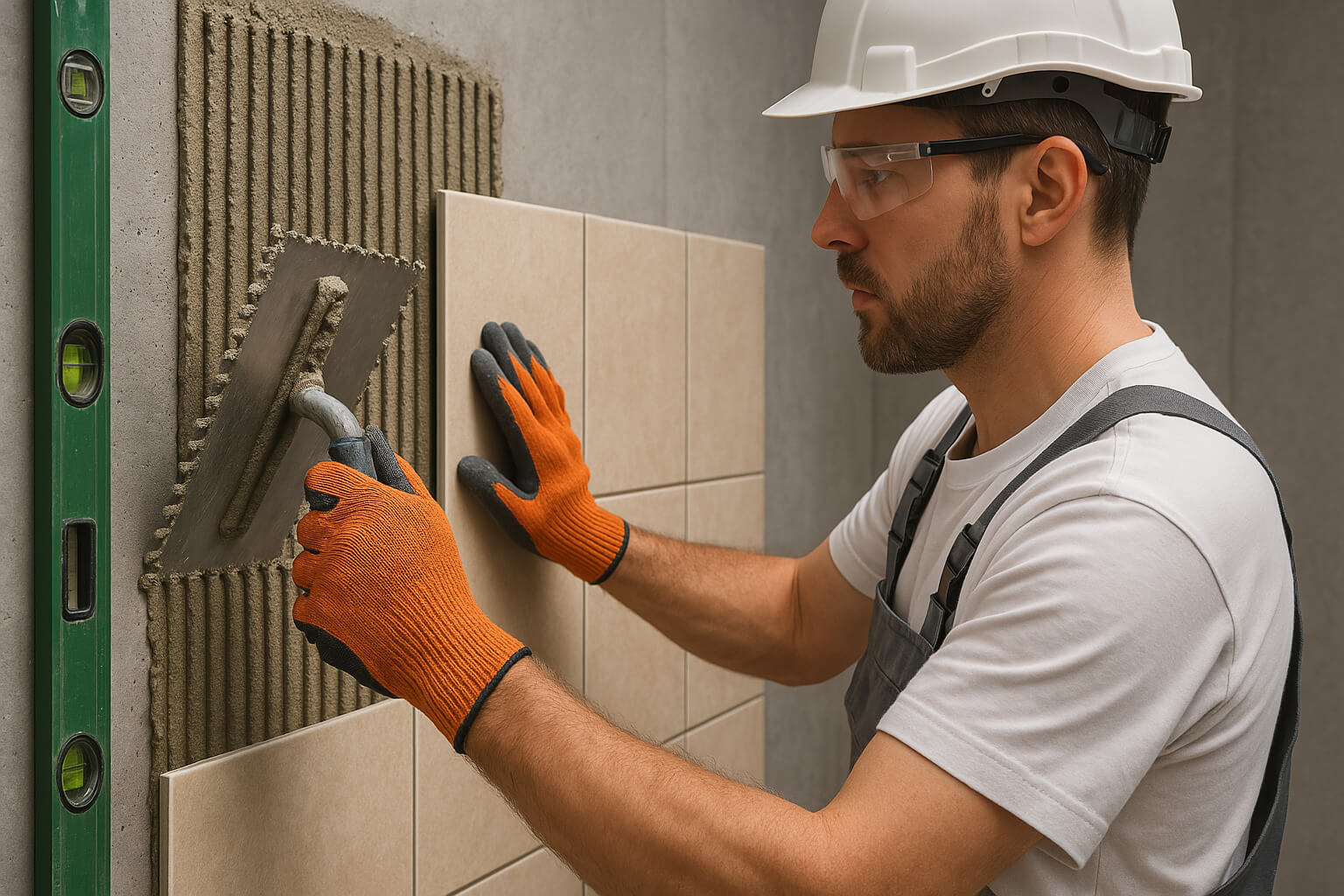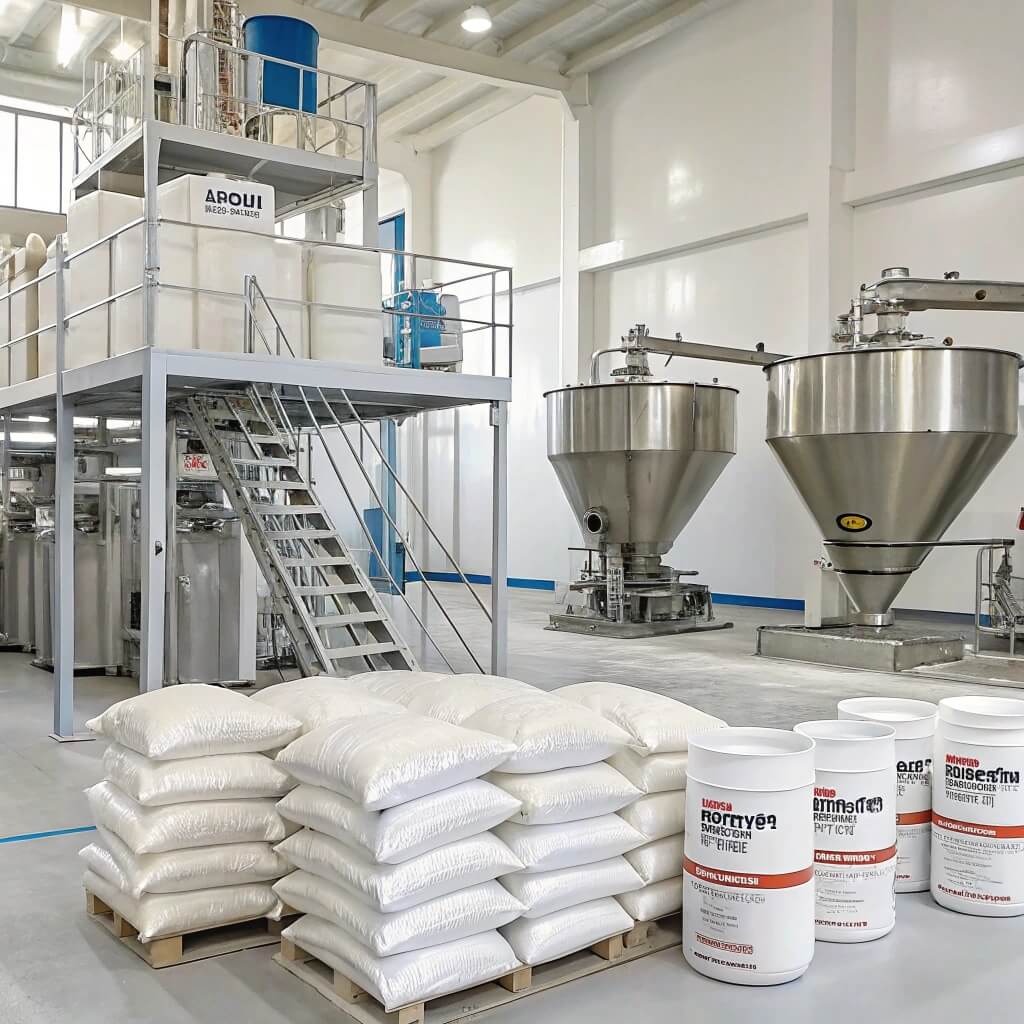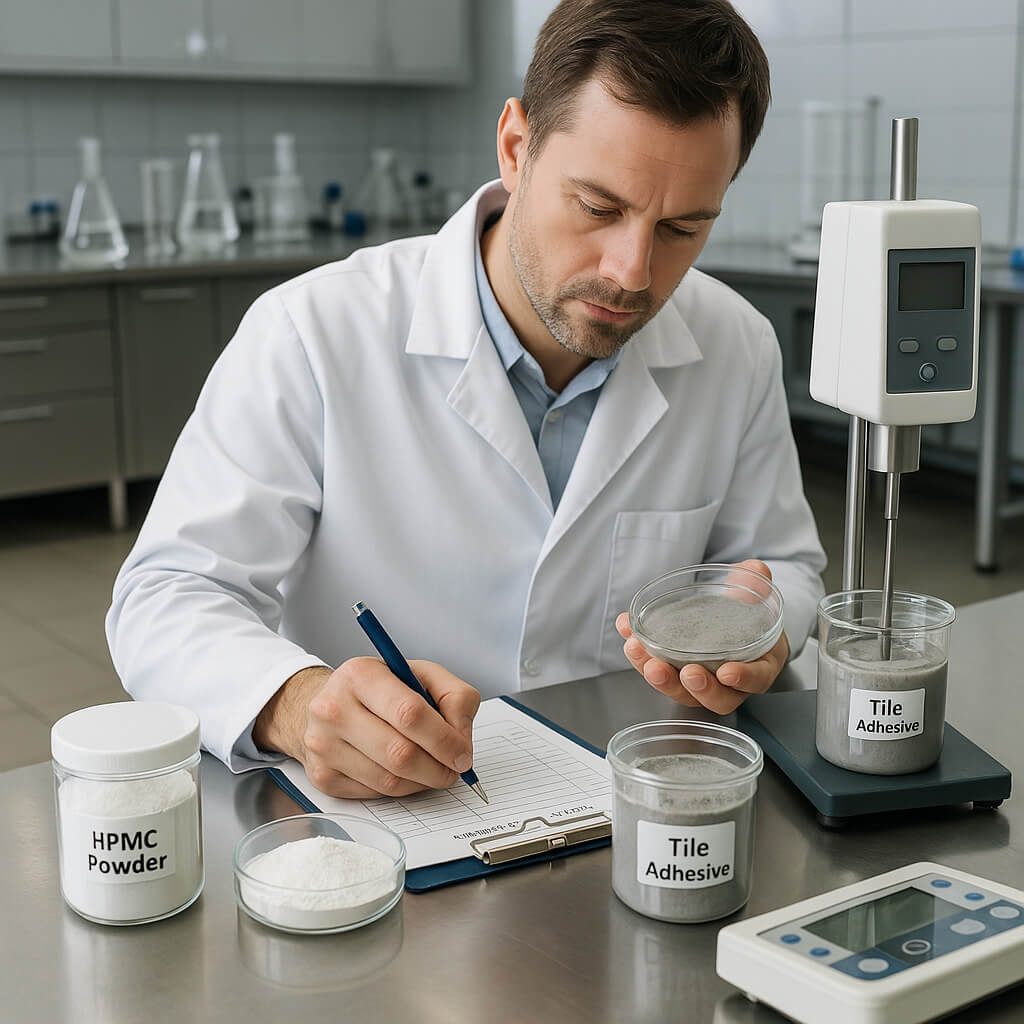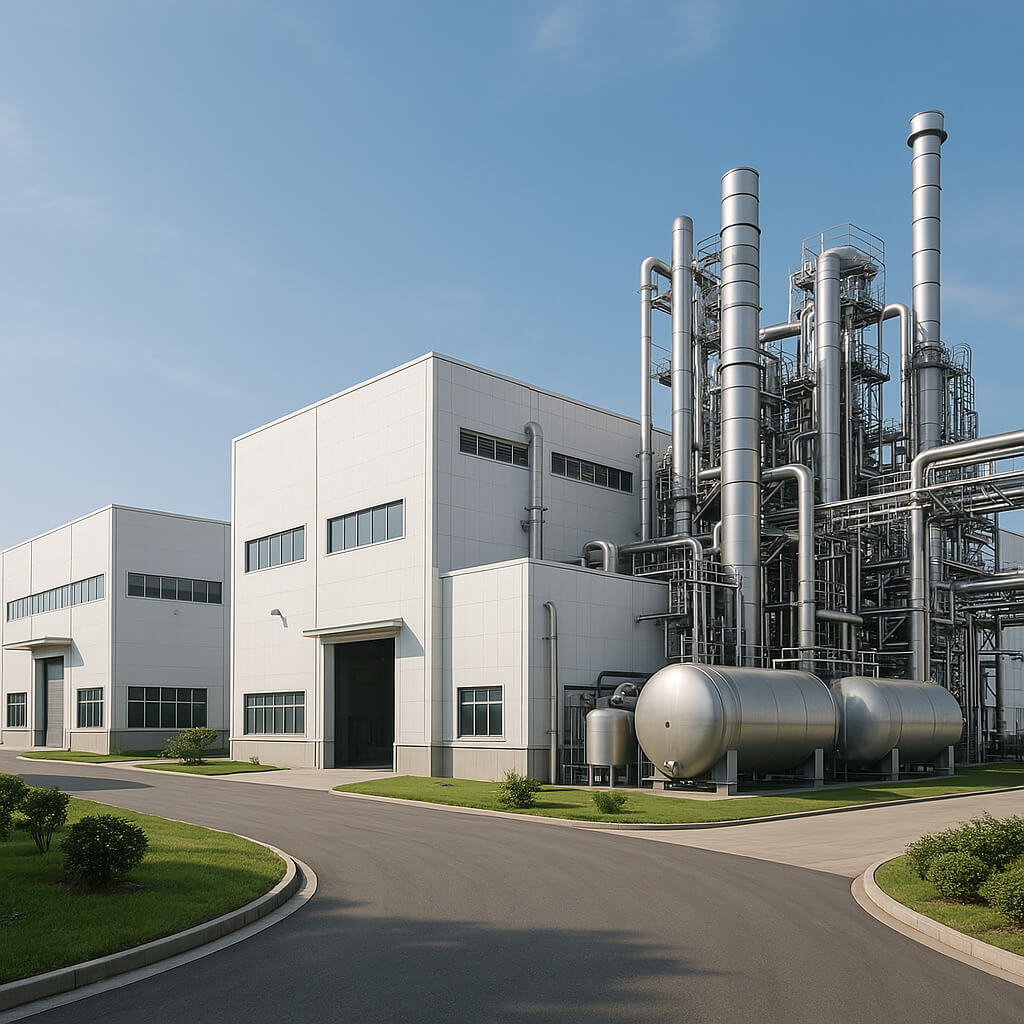Wall tile installations frequently fail due to slippage during setting. Heavy tiles slide downward, creating misaligned patterns and compromising the entire project’s quality.
Hydroxypropyl Methylcellulose (HPMC) significantly enhances slip resistance in tile adhesives by forming a three-dimensional gel network that creates thixotropic behavior, allowing the adhesive to flow under pressure during application but immediately resume a semi-solid state that prevents tile movement on vertical surfaces.

A professional installer applying large-format wall tiles using HPMC-modified adhesive that maintains position without slippage, demonstrating the polymer’s critical role in vertical installations.
Professional installers know that adhesive formulation directly impacts installation success. Let’s examine how HPMC creates the perfect balance of workability and stability for vertical tile applications.
What is the role of HPMC in tile adhesive formulation?
Traditional cement mixtures lack the critical properties needed for modern tiling methods. Without proper additives, adhesives dry too quickly, fail to maintain consistency, and slide during vertical applications.
HPMC serves as a multifunctional rheology modifier in tile adhesives, primarily enhancing water retention to extend open time while simultaneously creating thixotropic behavior, improving cohesive strength, and providing the critical anti-sag properties essential for vertical installations.
Through our decade of manufacturing experience, we’ve observed how HPMC transforms basic cement mixtures into professional-grade adhesives. This transformation stems from HPMC’s unique molecular structure, which contains both hydrophobic and hydrophilic regions. When dispersed in water, these regions create complex interactions that fundamentally alter the adhesive’s physical properties.
The primary functions of HPMC in tile adhesive formulations include:
- Water retention – extends working time from minutes to hours
- Rheology modification – creates ideal consistency for application
- Anti-sag capability – prevents vertical movement during setting
- Improved wetting – enhances contact with both tile and substrate
- Increased cohesion – strengthens internal bonds within the adhesive layer
These functions work together synergistically to create a balanced adhesive system. The water retention properties ensure adequate open time for proper tile placement, while the rheological modifications provide the crucial physical stability needed to hold tiles in position during the critical setting period.
Our laboratory testing demonstrates that HPMC significantly impacts adhesive structure at the microscopic level. The polymer forms a secondary network throughout the cement matrix, physically connecting particles while creating spaces where water remains available for proper hydration. This dual function maintains workability while providing structural integrity.
From a chemical perspective, HPMC’s hydroxypropyl groups interact with water molecules through hydrogen bonding, physically slowing evaporation and migration. Simultaneously, the hydrophobic portions create weak attractive forces within the adhesive mass, improving cohesion without compromising ultimate flexibility.
This combination of water retention and rheology modification directly addresses the most common installation challenges. Without HPMC, traditional cement mortars rapidly lose workability and lack the cohesion necessary to hold tiles in position, particularly on vertical surfaces. The polymer’s presence transforms these basic mixtures into specialized adhesives capable of supporting modern installation techniques.
The rheological properties HPMC imparts prove particularly valuable for vertical applications where gravity constantly works against the installer. By creating thixotropic behavior, HPMC allows the adhesive to flow easily during troweling but immediately resume a semi-solid state when pressure is removed. This characteristic creates the ideal application consistency according to studies on polymer-modified cement systems published in construction materials journals.
How does HPMC enhance slip resistance during vertical tile installation?
Vertical tile installations create unique challenges that many adhesives fail to address. Heavy tiles exert constant downward force, creating immediate slippage and long-term bond failures.
HPMC enhances slip resistance through three primary mechanisms: it creates immediate stiffening when shear forces stop, establishes temporary hydrogen bonding networks that resist gravitational forces, and modifies surface tension properties to create enhanced friction between the adhesive and tile backing.
Our manufacturing facility produces specialized HPMC grades specifically engineered for vertical tiling applications. Through this experience, we’ve gained deep insight into the precise mechanisms that contribute to anti-slip performance. The science behind this critical property involves several interconnected physical phenomena.
The most important mechanism involves HPMC’s ability to create thixotropic behavior in the adhesive matrix. Thixotropy represents a time-dependent shear thinning property—materials become less viscous under stress but regain viscosity when the stress is removed. When an installer applies pressure during troweling, the adhesive flows smoothly and evenly. The moment that pressure ceases, the HPMC-modified system rapidly returns to a higher viscosity state capable of resisting gravitational forces on the tiles.
This recovery happens almost instantly, creating immediate support for tiles pressed into the adhesive layer. Our rheological testing shows that properly formulated HPMC systems regain 80-90% of their original viscosity within seconds after pressure removal. This rapid recovery proves crucial for preventing the initial slip that often occurs with inadequate adhesives.
Beyond thixotropy, HPMC creates a temporary physical structure within the adhesive through hydrogen bonding networks. These networks form between HPMC molecules, water, and the mineral components of the cement mixture. While individually weak, the cumulative effect of countless hydrogen bonds creates substantial resistance to tile movement. This structure maintains integrity during the critical period between installation and initial cement hydration.
The polymer’s effect on surface tension further enhances slip resistance. HPMC slightly reduces the surface tension of water within the adhesive, improving wetting characteristics against both the substrate and tile backing. This improved wetting creates more complete surface contact, maximizing frictional forces that resist movement. The microscopic "suction" effect that results helps counteract gravity’s constant pull on vertical tiles.
Particle distribution within the adhesive matrix also plays a crucial role in slip resistance. HPMC helps maintain homogeneous dispersion of cement and aggregate particles, preventing segregation that might create weak zones susceptible to slippage. This consistent distribution ensures that the entire adhesive layer provides uniform support against gravitational forces.
Time-dependent viscosity development represents another significant factor. As water gradually migrates within the adhesive system, HPMC concentrations increase in certain regions, creating progressive stiffening that further enhances slip resistance over time. This gradual strengthening process bridges the gap between initial placement and final cement hydration.
Our field testing with professional installers confirms these mechanisms translate directly to practical benefits. In controlled comparisons between HPMC-modified and unmodified adhesives under identical conditions, the HPMC systems consistently demonstrate superior slip resistance, particularly with larger format tiles where gravitational forces are greatest. This performance advantage meets industry standards for vertical applications as established by tile council technical committees.
What physical and chemical properties of HPMC affect anti-slip behavior?
Generic HPMC grades often deliver inconsistent performance. Without understanding the specific properties that influence slip resistance, manufacturers select inappropriate types that fail to provide adequate support.
The critical HPMC properties affecting anti-slip behavior include molecular weight (determining gel strength), methoxyl content (influencing hydrophobicity and gel development), particle size distribution (affecting dissolution rate), and hydroxypropyl substitution degree (controlling water interaction and cohesion development).
Through our extensive manufacturing experience, we’ve identified several key structure-property relationships that directly influence HPMC’s effectiveness in preventing tile slippage. These relationships provide formulators with specific guidance for selecting optimal HPMC grades for vertical applications.
Molecular weight stands as perhaps the most significant factor. Higher molecular weight HPMC grades (typically >150,000 Daltons) create stronger gel networks with superior resistance to deformation under stress. This characteristic directly enhances slip resistance by providing greater structural integrity within the adhesive matrix. Our laboratory testing shows a near-linear relationship between molecular weight and slip resistance up to certain threshold values, beyond which other factors become limiting.
The methoxyl content of HPMC significantly influences its interaction with both water and the cement matrix. Higher methoxyl percentages (28-30%) generally provide better gel structure development and enhanced thixotropic behavior. This substitution pattern creates a balance of hydrophilic and hydrophobic regions that optimizes the polymer’s contribution to slip resistance. Adhesives containing HPMC with properly balanced methoxyl content typically demonstrate 30-40% improvement in vertical hold capability compared to systems using unoptimized grades.
| HPMC Property | Impact on Slip Resistance | Optimal Range for Vertical Applications | Mechanism of Action |
|---|---|---|---|
| Molecular Weight | High influence | 150,000-400,000 Daltons | Stronger gel networks, increased viscosity recovery |
| Methoxyl Content | Moderate influence | 28-30% | Balanced hydrophobic/hydrophilic interactions |
| Hydroxypropyl Substitution | Moderate influence | 7-12% | Controls water affinity and network formation |
| Particle Size | Low to moderate influence | 95% < 100 μm | Affects dissolution rate and dispersion uniformity |
| Gel Temperature | Moderate influence | 65-75°C | Higher values improve stability in warm conditions |
The hydroxypropyl substitution degree also significantly impacts performance. This parameter controls the polymer’s water affinity and dissolution behavior. Our testing indicates that moderate substitution levels (7-12%) provide optimal performance for vertical applications. Lower substitution can result in poor dissolution and inadequate gel formation, while excessive substitution may reduce cohesive strength within the adhesive matrix.
Particle size distribution affects both manufacturing processes and final performance. Finer HPMC particles dissolve more rapidly, creating faster viscosity development when water is added to the dry mixture. This characteristic proves particularly important for vertical applications where immediate support is critical. However, extremely fine particles can create processing challenges like dusting and uneven dispersion within dry mixes. Optimal grades balance these factors with distributions typically targeting 95% below 100 microns.
Thermal gelation temperature represents another significant property. HPMC exhibits inverse solubility behavior—forming stronger gels at higher temperatures up to certain limits. Grades with gelation temperatures in the 65-75°C range generally provide better stability across varying installation conditions. This property becomes particularly important for vertical applications in warm environments where standard grades might lose effectiveness.
These property-performance relationships don’t exist in isolation but interact in complex ways. Our formulation scientists work extensively with adhesive manufacturers to identify optimal HPMC specifications based on their specific production methods, regional conditions, and performance requirements. This customized approach ensures that the selected HPMC grade delivers consistent anti-slip performance across production batches as verified through construction materials testing protocols.
How can manufacturers optimize HPMC use for better tile adhesive performance?
Many manufacturers struggle with inconsistent anti-slip performance despite using HPMC. Improper incorporation techniques, dosage miscalculations, and complementary additive conflicts create quality control challenges.
Manufacturers can optimize HPMC performance by selecting appropriate viscosity grades (40,000-100,000 mPa·s for vertical applications), utilizing proper dry pre-blending techniques, maintaining dosage precision between 0.3-0.5%, calibrating water content specifically for HPMC hydration needs, and balancing with complementary additives like redispersible polymers.
Our technical support team regularly assists adhesive manufacturers with optimization strategies based on their specific production capabilities and performance targets. These approaches have proven successful across diverse manufacturing environments and regional markets.
The most fundamental optimization involves proper HPMC grade selection. For vertical applications requiring maximum slip resistance, medium to high viscosity grades (40,000-100,000 mPa·s) typically provide optimal performance. These grades deliver sufficient gel strength to resist gravitational forces while maintaining workability. Manufacturers should select specific viscosity levels based on their target applications—higher viscosity for heavier tiles and more demanding vertical installations.
Dosage precision plays a crucial role in performance consistency. For vertical applications, HPMC dosage typically ranges from 0.3% to 0.5% of the total dry mixture weight, with the higher end providing maximum slip resistance. Given these relatively low concentrations, measurement accuracy becomes critical. Production facilities should utilize calibrated weighing systems with precision appropriate for their batch sizes—typically ±0.01% accuracy or better. Regular calibration and verification procedures help maintain this precision across production runs.
Incorporation techniques significantly impact HPMC effectiveness. The optimal approach involves thorough pre-blending with a portion of dry aggregates or fillers before introducing this mixture into the main batch. This pre-blending physically separates HPMC particles, preventing agglomeration when water is added. The complete dry mixture should then undergo sufficient mixing (minimum 3-5 minutes in high-efficiency mixers) to ensure uniform distribution before water addition.
Water content calibration represents another critical optimization opportunity. HPMC requires sufficient water for complete hydration and gel formation. However, excessive water reduces overall adhesive strength and can compromise slip resistance. Manufacturers should determine the optimal water-to-cement ratio that balances HPMC hydration needs with final performance requirements. Our laboratory testing typically shows optimal ranges between 0.50-0.55 water-to-cement ratio for HPMC-modified systems targeted for vertical applications.
Mixing procedures also significantly impact performance. After water addition, sufficient mixing time (typically 5-7 minutes in professional equipment) ensures complete HPMC hydration and uniform distribution throughout the mixture. Inadequate mixing results in uneven performance with areas of weak slip resistance that can lead to installation failures.
Complementary additives create both opportunities and challenges for HPMC optimization. Redispersible polymer powders (RPP) can work synergistically with HPMC to enhance slip resistance through different mechanisms. However, some additives—particularly certain superplasticizers or air-entraining agents—may interfere with HPMC’s gel structure development. Manufacturers should evaluate additive compatibility through systematic testing rather than simple trial and error.
Storage stability represents a final optimization consideration. HPMC-modified dry mixtures should be protected from humidity exposure, as partial hydration before use can significantly impact performance. Proper packaging materials and storage conditions help maintain consistent performance throughout the product’s shelf life.
By implementing these optimization strategies, manufacturers can achieve remarkably consistent anti-slip performance while potentially reducing overall formulation costs. Our technical service team regularly helps customers develop customized testing protocols aligned with international standards to verify optimization results and ensure reliable field performance.
What testing methods are used to measure slip resistance in tile adhesives?
Inadequate testing leads to field failures and customer complaints. Without standardized measurement procedures, manufacturers cannot reliably predict vertical installation performance.
Industry-standard slip resistance testing methods include the EN 1308 vertical slip measurement procedure, the modified Sag Test for dynamic loading, rheological characterization through viscosity recovery assessment, and field simulation testing with actual tile systems to verify real-world performance under varying conditions.
Laboratory Test Methods
Our quality control laboratories utilize comprehensive testing protocols to evaluate slip resistance across different HPMC grades and adhesive formulations. These standardized methods provide quantitative measurements that accurately predict field performance.
The European standard EN 1308 outlines the most widely recognized procedure for measuring vertical slip in ceramic tile adhesives. This method involves applying a standard adhesive layer to a vertical substrate, placing a specified tile (typically 500g) onto the adhesive, and measuring the downward displacement after 20 minutes. Class T adhesives must demonstrate slip less than 0.5mm under these conditions. This standardized approach allows direct comparison between different formulations and verification of performance against international requirements.
Beyond the static EN 1308 procedure, many manufacturers employ dynamic testing to simulate real-world conditions. The modified Sag Test represents one such approach, measuring slip resistance under vibration or impact loading. This method better replicates actual installation conditions where nearby construction activity or other vibrational sources might affect adhesive performance. Our testing shows that HPMC’s contribution to slip resistance remains particularly valuable under these dynamic conditions compared to other rheology modifiers.
Rheological characterization provides deeper insight into the fundamental properties affecting slip resistance. These tests typically employ rheometers to measure viscosity recovery after shear stress removal—directly quantifying the thixotropic behavior critical for vertical performance. Our laboratories utilize rotational rheometers with controlled stress capabilities to precisely measure how quickly HPMC-modified adhesives regain viscosity after troweling. The recovery rate and final viscosity values strongly correlate with field performance in vertical applications.
Water retention testing, while not directly measuring slip resistance, provides complementary data highly relevant to vertical performance. The DIN 18555-7 method or similar procedures quantify how effectively the adhesive retains water under standardized suction conditions. Higher water retention typically correlates with improved slip resistance as it maintains the optimal consistency required for vertical stability.
Real-tile testing represents perhaps the most practical laboratory approach. This method uses actual commercial tiles of various weights and surface characteristics to directly measure slip under controlled conditions. By testing with a range of tile sizes and weights, manufacturers can establish clear performance limits for specific formulations. Our testing facilities maintain extensive tile libraries for this purpose, allowing customers to verify performance with their target installation materials.
Thermal stability testing evaluates slip resistance across temperature ranges, an important consideration for adhesives used in varying environments. Temperature cycling between 10°C and 35°C during curing can identify formulations with inconsistent performance under real-world conditions. HPMC grades with appropriate thermal gelation properties maintain consistent slip resistance across this temperature range.
For comprehensive performance validation, many manufacturers combine multiple test methods rather than relying on a single procedure. This approach provides a more complete understanding of how the adhesive will perform across diverse installation scenarios. Our technical support programs help customers develop appropriate testing combinations based on their specific market requirements and application conditions.
Field Verification Methods
Laboratory testing provides essential data but field verification remains crucial for complete performance validation. Professional installers evaluate slip resistance through standardized procedures including:
- Vertical wall installation with maximum recommended tile weight
- Measurement of displacement at 10, 30, and 60 minutes
- Assessment of adjustment capability without inducing slip
- Evaluation of performance under adverse conditions (high temperature, high humidity)
These practical assessments complement laboratory data to ensure comprehensive performance validation. The combined approach ensures that the selected HPMC grade delivers reliable slip resistance in actual construction environments as verified through ISO construction material testing frameworks.
FAQs
What is the recommended HPMC viscosity for optimal tile adhesive performance?
The optimal HPMC viscosity for tile adhesives typically ranges between 40,000-100,000 mPa·s (measured as a 2% aqueous solution at 20°C), with specific applications requiring different points within this range. For standard wall installations, 40,000-60,000 mPa·s usually provides sufficient slip resistance while maintaining good workability. Heavy tile installations or challenging vertical applications benefit from higher viscosity grades (75,000-100,000 mPa·s) that create stronger gel structures and enhanced stability. Floor tile applications can utilize lower viscosity grades (15,000-30,000 mPa·s) where slip resistance is less critical and improved flow characteristics benefit installation.
How does HPMC’s water retention affect tile adhesive curing time?
HPMC’s water retention capability extends tile adhesive curing time by maintaining adequate moisture for complete cement hydration while slowing surface drying. Standard cement mixtures without HPMC typically begin surface hardening within 1-2 hours but often continue internal curing for days. HPMC-modified systems (0.3-0.5% dosage) typically extend initial setting to 3-6 hours while promoting more complete internal curing. This controlled moisture environment prevents the premature surface drying that can compromise bond strength, particularly on porous substrates or in high-temperature conditions, ultimately creating stronger, more durable installations despite the extended initial setting period.
Are there compliance standards for HPMC use in tile adhesives?
HPMC itself must meet several purity and performance standards for construction applications, including compliance with European Pharmacopoeia (EP) specifications regarding heavy metal limits and solvent residues. For tile adhesives containing HPMC, the finished products must comply with EN 12004, which classifies cementitious adhesives (type C) with various performance designations including extended open time (E) and reduced slip (T) – properties directly enhanced by HPMC. Additionally, some regional markets require specific certifications like the French VOC emissions class A+ or German DIBT approval. Most major manufacturers maintain internal standards exceeding these regulatory requirements.
What are the best practices for incorporating HPMC into tile adhesive formulations?
Best practices for HPMC incorporation include thoroughly pre-blending it with dry aggregates or fillers (approximately 10-20 times the HPMC weight) before introducing this mixture into the main batch. This prevents gel lump formation when water is added. Manufacturers should utilize high-efficiency mixers with sufficient dry mixing time (3-5 minutes minimum) to ensure uniform HPMC distribution. Water temperature should be controlled between 15-25°C (59-77°F) for optimal dissolution, with water added gradually while mixing continues. After water addition, continue mixing for 5-7 minutes to achieve complete hydration. Quality control should include regular water retention testing to verify proper HPMC performance in each production batch.
Conclusion
HPMC plays an indispensable role in creating the slip resistance essential for successful vertical tile installations. Through its unique combination of thixotropic behavior, network-forming capabilities, and rheology modification, HPMC transforms ordinary cement mixtures into high-performance adhesives capable of supporting even heavy tiles on vertical surfaces without movement.
Our manufacturing experience confirms that properly selected and incorporated HPMC directly addresses the most challenging aspects of vertical tile installation. The immediate viscosity recovery after troweling creates instant support for tiles, while the extended water retention ensures proper cement hydration and bond development. This balance of immediate stability and long-term strength makes HPMC-modified adhesives the preferred choice for professional installers.
For adhesive manufacturers seeking to enhance vertical performance capabilities, contact our technical team at Morton for specialized construction-grade HPMC tailored specifically for slip-resistant applications. Our expertise in both polymer chemistry and practical application requirements ensures you’ll receive the optimal HPMC solution for your specific manufacturing processes and market needs.




